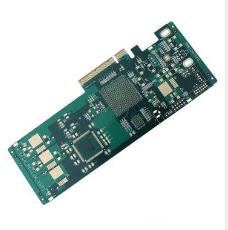First of all, I must say that high Tg refers to high heat resistance. With the rapid development of the electronics industry, especially the electronic products represented by computers, the development of high functionality and high multilayers requires higher heat resistance of PCB substrate materials as an important guarantee. The emergence and development of high-density mounting technologies represented by SMT and CMT have made PCBs more and more inseparable from the support of high heat resistance of substrates in terms of small aperture, fine wiring, and thinning.
Under high temperature, PCB substrate materials not only produce softening, deformation, melting, etc., but also show a sharp decline in mechanical and electrical characteristics (I think you don't want to see this in your own products). Therefore, the difference between general FR-4 and high Tg FR-4 is the mechanical strength, dimensional stability, adhesion, water absorption, and thermal decomposition of the material in the hot state, especially when heated after moisture absorption. There are differences in various conditions such as thermal expansion, and high Tg products are obviously better than ordinary PCB substrate materials.

The high frequency of electronic equipment is a development trend, especially with the increasing development of wireless networks and satellite communications, information products are moving towards high speed and high frequency, and communication products are moving towards the standardization of voice, video and data for wireless transmission with large capacity and speed. Therefore. The development of a new generation of products requires high-frequency substrates.
Digital microwave system (base station to base station reception) 10 ~ 38GHz High frequency PCB circuit board s must be applied to communication products such as satellite systems and mobile phone receiving base stations in the above table. In the next few years, they will inevitably develop rapidly, and high frequency substrates will be in large demand. .
The basic characteristics of high-frequency substrate materials require the following points:
(1) The dielectric constant (Dk) must be small and stable. Generally, the smaller the better, the signal transmission rate is inversely proportional to the square root of the material's dielectric constant. High dielectric constant is likely to cause signal transmission delay.
(2) The dielectric loss (Df) must be small, which mainly affects the quality of signal transmission. The smaller the dielectric loss, the smaller the signal loss.
(3) The thermal expansion coefficient of the copper foil should be as consistent as possible, because the inconsistency will cause the copper foil to separate in the cold and heat changes.
(4) Low water absorption and high water absorption will affect the dielectric constant and dielectric loss when damp.
(5) Other heat resistance, chemical resistance, impact strength, peel strength, etc. must also be good.
Generally speaking, high frequency can be defined as the frequency above 1GHz. At present, the most commonly used high frequency circuit board substrate is a fluorine dielectric substrate, such as polytetrafluoroethylene (PTFE), which is usually called Teflon, and is usually used in Above 5GHz. In addition, FR-4 or PPO substrates are also used, which can be used for products between 1GHz and 10GHz.
Water absorption (%) Low Medium High The three types of high-frequency substrate materials, namely epoxy resin, PPO resin, and fluorine-based resin used at this stage, are epoxy resins with the cheapest cost, while fluorine-based resins are the most expensive. Considering the electrical constant, dielectric loss, water absorption and frequency characteristics, fluorine-based resin is the best and epoxy resin is inferior. When the frequency of the product application is higher than 10GHz, only the fluorine-based resin printed board can be applied. Obviously, the performance of fluorine-based resin high-frequency substrates is much higher than that of other substrates, but its shortcomings are poor rigidity and large thermal expansion coefficient in addition to high cost. For polytetrafluoroethylene (PTFE), in order to improve performance, a large amount of inorganic substances (such as silica SiO2) or glass cloth are used as reinforcing fillers to increase the rigidity of the substrate and reduce its thermal expansion. In addition, due to the molecular inertness of the PTFE resin itself, it is not easy to bond with the copper foil, so special surface treatment on the bonding surface of the copper foil is required. The treatment method includes chemical etching or plasma etching on the surface of PTFE to increase the surface roughness or add a layer of adhesive film between the copper foil and the PTFE resin to improve the bonding force, but it may affect the performance of the medium. Influence.
The development of the entire fluorine-based high-frequency circuit board requires the cooperation of raw material suppliers, research units, equipment suppliers,PCB manufacturers, and communication product manufacturers to keep up with the rapid development of high-frequency circuit boards in this field. .